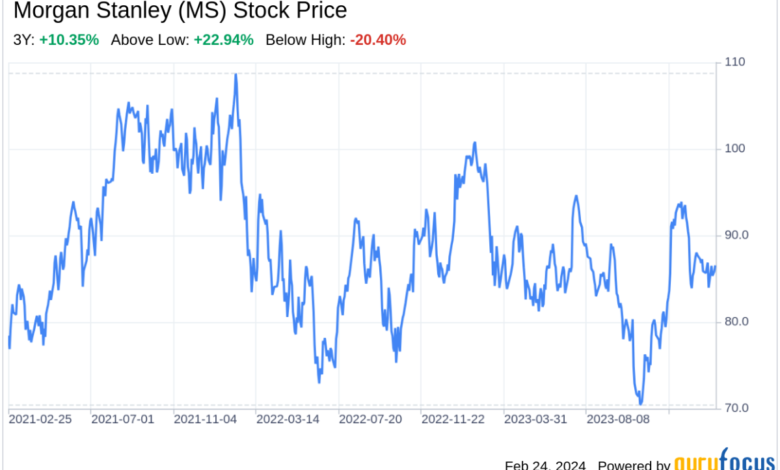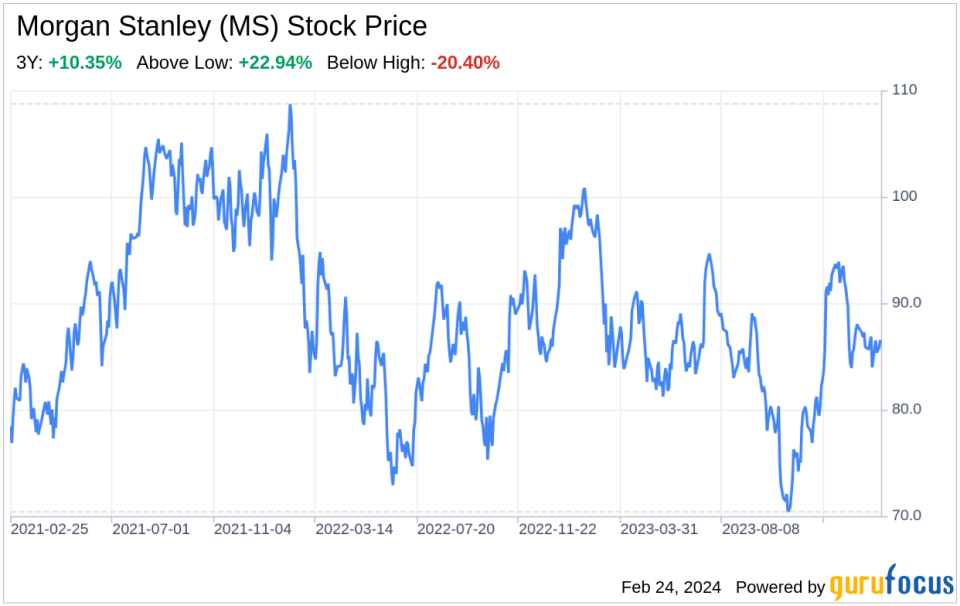Decoding Morgan Stanley (MS): A Strategic SWOT Insight

-
Comprehensive SWOT analysis based on the latest SEC 10-K filing.
-
Deep dive into Morgan Stanley’s strengths, weaknesses, opportunities, and threats.
-
Data-driven insights to inform investment decisions and understand Morgan Stanley’s strategic direction.
-
Expert analysis of financial performance and market trends impacting Morgan Stanley.
On February 22, 2024, Morgan Stanley (NYSE:MS), a leading global investment bank with a rich history dating back to 1924, filed its annual 10-K report with the Securities and Exchange Commission (SEC). This filing provides a detailed look at the company’s financial health and strategic positioning. With over $4 trillion in client assets and a workforce exceeding 80,000 employees, Morgan Stanley operates through three primary segments: Institutional Securities, Wealth Management, and Investment Management. The company’s revenue is well-diversified, with approximately 50% stemming from institutional securities and the remainder from wealth and investment management. Notably, 30% of total revenue is generated outside the Americas, indicating a strong international presence. A review of the financial tables within the filing reveals a robust balance sheet, with significant market positions in each of its business segments, highlighting Morgan Stanley’s financial resilience and adaptability in the dynamic financial services landscape.


Strengths
Market Position and Diversified Revenue Streams: Morgan Stanley’s prominent market position is a testament to its enduring brand and diversified revenue streams. The company’s institutional securities business, accounting for half of its net revenue, is complemented by its wealth and investment management segments. This diversification not only mitigates risk but also allows for consistent revenue generation across various market conditions. The strength of its market position is further evidenced by its expansive global footprint, with a significant portion of revenue derived from international operations, showcasing its ability to attract and serve a global client base.
Robust Financial Performance: The company’s financial health is a cornerstone of its strength. Morgan Stanley’s balance sheet, as reflected in the 10-K filing, demonstrates solid financial performance with substantial assets under management. The firm’s ability to generate revenue and control costs effectively has resulted in a strong capital position, enabling strategic investments and shareholder returns. This financial stability is crucial in weathering economic fluctuations and investing in growth opportunities.
Weaknesses
Regulatory and Compliance Risks: As a global financial institution, Morgan Stanley is subject to a complex regulatory environment that can impact its operations and profitability. The filing underscores the challenges posed by stringent capital and liquidity requirements, which can constrain the company’s ability to engage in certain transactions and increase operational costs. These regulatory pressures necessitate continuous investment in compliance and risk management systems, potentially diverting resources from other strategic initiatives.
Competitive Pressures and Technological Disruption: The financial services industry is highly competitive, with traditional and non-traditional players vying for market share. Morgan Stanley faces intense competition from banks, investment firms, fintech companies, and other financial service providers. The rise of digital asset capabilities and automated trading platforms has intensified this competition, putting pressure on the company to innovate and adapt continuously. Failure to keep pace with technological advancements and evolving customer preferences could erode Morgan Stanley’s competitive edge.
Opportunities
Technological Innovation and Digital Transformation: The rapid evolution of financial technology presents Morgan Stanley with opportunities to enhance its service offerings and operational efficiency. Investing in digital platforms, such as online trading and banking services, can attract a new generation of clients and improve the customer experience. Embracing technological innovation can also lead to cost savings and more effective risk management, positioning the company to capitalize on the digital transformation of the financial industry.
Strategic Acquisitions and Alliances: Morgan Stanley’s strong capital position enables it to pursue strategic acquisitions and alliances that can expand its market presence and product offerings. By acquiring or partnering with fintech firms and other innovative companies, Morgan Stanley can access new technologies, enter emerging markets, and diversify its revenue streams. These strategic moves can bolster the company’s competitive position and drive long-term growth.
Threats
Global Economic and Political Uncertainties: The company operates in a global landscape fraught with economic and political uncertainties, including trade policies, geopolitical events, and changes in tax laws. Such external factors can adversely affect investor sentiment, market stability, and the company’s international operations. Morgan Stanley must navigate these challenges carefully to maintain its financial performance and client confidence.
Cybersecurity and Data Privacy Concerns: In an increasingly digital world, cybersecurity threats and data privacy concerns pose significant risks to financial institutions like Morgan Stanley. A data breach or cyber-attack can lead to substantial financial losses, reputational damage, and erosion of client trust. The company must prioritize robust cybersecurity measures and data protection protocols to safeguard its operations and sensitive client information.
In conclusion, Morgan Stanley (NYSE:MS) exhibits a strong market position with diversified revenue streams and robust financial performance, which are central to its competitive advantage. However, it must contend with regulatory complexities, competitive pressures, and technological disruption. Opportunities for growth lie in technological innovation and strategic acquisitions, while global economic uncertainties and cybersecurity threats present ongoing challenges. By leveraging its strengths and addressing its weaknesses, Morgan Stanley can capitalize on emerging opportunities and mitigate potential threats, ensuring its continued success in the dynamic financial services sector.
This article, generated by GuruFocus, is designed to provide general insights and is not tailored financial advice. Our commentary is rooted in historical data and analyst projections, utilizing an impartial methodology, and is not intended to serve as specific investment guidance. It does not formulate a recommendation to purchase or divest any stock and does not consider individual investment objectives or financial circumstances. Our objective is to deliver long-term, fundamental data-driven analysis. Be aware that our analysis might not incorporate the most recent, price-sensitive company announcements or qualitative information. GuruFocus holds no position in the stocks mentioned herein.
This article first appeared on GuruFocus.
Source link





